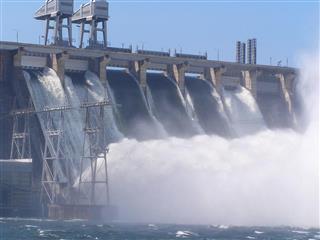
Without electricity, our lives would have come to a halt. Its use has become so inevitable, that seldom do people think about how it is generated. To know more about various methods that are used to generate electrical energy, read this article.
| Fast Fact A single bolt of lightning can carry a mind-boggling 5 billion joules of electricity, and is so powerful that about 150 million light bulbs can be illuminated by it. This is enough electrical energy for an entire city to operate without depending on other sources for a single day! |
Electricity is generated from sources such as water, wind, and the sun’s rays. However, these are indirect sources. The direct sources of transforming energy into electricity are static energy, electromagnetic induction, and chemical energy. It also includes the photoelectric process (transforming light into electrical energy), direct conversion of temperature differences, nuclear energy, etc.
A major chunk of electricity generation is driven by heat engines. The heat is mostly supplied by combustion of fossil fuels, nuclear fission, and other renewable energy sources. Following are the main techniques that are used for generating electricity.
Power Generation Methods
Turbines
These devices are mostly propelled by a fluid or gas that acts as an energy carrier. Turbines can be propelled by wind or flowing water. Steam is one of the sources that can power turbines, and for this medium, water is boiled with the help of heat from methods involving nuclear fission, burning coal, natural gas, or petroleum. The main methods of generating electricity have been discussed below.
The first step consists of grounding the coal blocks evenly to fine fragments, and placing them in a furnace that is attached to a water boiler. After undergoing heating and combustion, the water boils, and the resultant steam is used to drive the turbines to generate electricity. An alternate method is by using coal water slurry (CWS) fuel, which helps improve the efficiency of power generation. Out of the total electricity generated on our planet, around 40% is derived by heating coal.
The interior of the Earth stores vast reserves of heat, which is basically transferred from the molten mantle to the crustal portions of our planet. Sources like hot water springs, geysers, and hot water aquifers are exploited by geothermal power stations. With the help of mediums like injecting cold water and other fluids, the steam generated from such sources is trapped and further used to power turbines for electricity generation. More than 15% of the total electricity in Iceland is derived from geothermal energy.
Animal dung, wood chips, parts of plants like branches and leaves, organic waste materials, decaying animal mass, etc., are major examples of biomass. These materials can be burned or made to undergo combustion in order to generate heat, which is further used to produce electrical energy. Some of the sources are also fermented to generate biogas, which can be readily burned and converted to electricity with the help of biogas power plants. Biomass is a very promising and important source of renewable energy, and its use for electricity generating purposes is steadily increasing.
Using wind energy is another way of producing electricity. Windmills are devices that harness wind energy, and act like turbines in order to produce electricity. The rotating blades are connected to generators via cables, which transfer kinetic energy to the generators. The wind turbine having the largest capacity of producing electricity is the Vesta V-164. Its capacity has been rated at 8 MW.
Water flowing at a great force can also drive a turbine to generate electricity. Dams are built between the course of a river not just for storage of water, but also for the generation of electricity through turbines. These turbines are set up at the reservoir power station, and water falling from a great height is used for their rotation action, which in turn starts the generators, ultimately producing electrical energy. More than 2000 hydroelectric power plants are present in the US, and they generate about 7% of the total electricity produced in the region.
Rapid advancement is also seen in the generation of electricity using tidal power. One of the most important inexhaustible energy sources – tidal plants, utilize the energy carried by waves that crash onto coastal areas with an enormous force. Turbines are built under the breaker zone inside cylindrical units, on which the waves hit with their maximum force. The high momentum of tidal waves helps in the rotation of turbines, and subsequently generates electrical energy. Tidal barrages and tidal stream generators are two main techniques involved in electricity production using the power of waves.
Photovoltaic Panels
They convert sunlight directly into electricity, unlike solar heat concentrators. Initially, they were considered to be best suited to rural areas, where there is no electricity grid or a proper infrastructure. But, with an increasing awareness about their environmental advantages, these panels are being used on a large scale around the world. Many experiments are being conducted to tap solar energy. Germany is the largest producer of photovoltaic panels, while countries harnessing the most advanced technology are China and Japan. The materials used for making solar chips are monocrystalline and polycrystalline silicon, cadmium telluride, copper sulfide, etc. The panels are enclosed in modules, which are then connected to respective devices with the help of copper cables. Photovoltaic cells are used for generating electricity in buildings, transportation (cars, trucks, bicycles, etc.), spacecraft and space stations, cell phone chargers, etc.
Nuclear Fission
When the nucleus of an atom splits, a chemical reaction occurs, which is called nuclear fission. This process takes place in a nuclear reactor. The most used mineral in the process of nuclear power generation is uranium. It is placed in the reactor’s core, and random neutrons are released in the core. These neutrons collide with the nucleus of a uranium atom, resulting in fission, thus creating a chain reaction. The consequence of this reaction is the production of a large amount of heat in the core. But there are coolants to tackle the heat which is absorbed, and is further transported to a steam boiler through a tube. After this, the heat from the coolant passes through the tube walls, which boils the water obtained from a nearby natural source. The heated H2O gets transformed into steam, which propels the turbine, leading to the generation of electricity. A major problem with this method is the production of nuclear waste, which is extremely harmful for the environment.
Fuel Cells
The devices that generate electricity with the help of chemical energy derived from certain fuels are known as fuel cells. In these devices, a chemical reaction takes place that involves the fuel, an oxidizing agent, and oxygen. They require a continuous supply of fuel and the required chemicals, in contrast to devices called batteries (used in cell phones, radios, laptop computers, etc.), which require a limited supply of chemicals, and can be charged multiple times. Various hydrocarbons, hydrogen, and methanol are some examples of the fuels used in this method, and of these options, hydrogen is the most preferred element to be used as a fuel. The reliability of these devices is more than that of other methods like coal-powered electricity generation plants, wind turbines, and photovoltaic panel-generated electricity. Being 99% efficient, they are widely used in numerous commercial applications. This technology can be said to be one of the most promising and emerging ones that might surpass other methods in the near future. Research is still on, regarding the manufacturing of such devices in accordance with environmental safety and conservation.
Besides these techniques, there are other methods for generating electricity (for example, batteries, static electricity, piezoelectric crystals, etc.), for which a lot of experiments are being conducted. These techniques are used on a relatively small scale as compared to the above-described methods. Innovations in this field may lead to minimizing the use of non-renewable energy sources for electricity generation.








